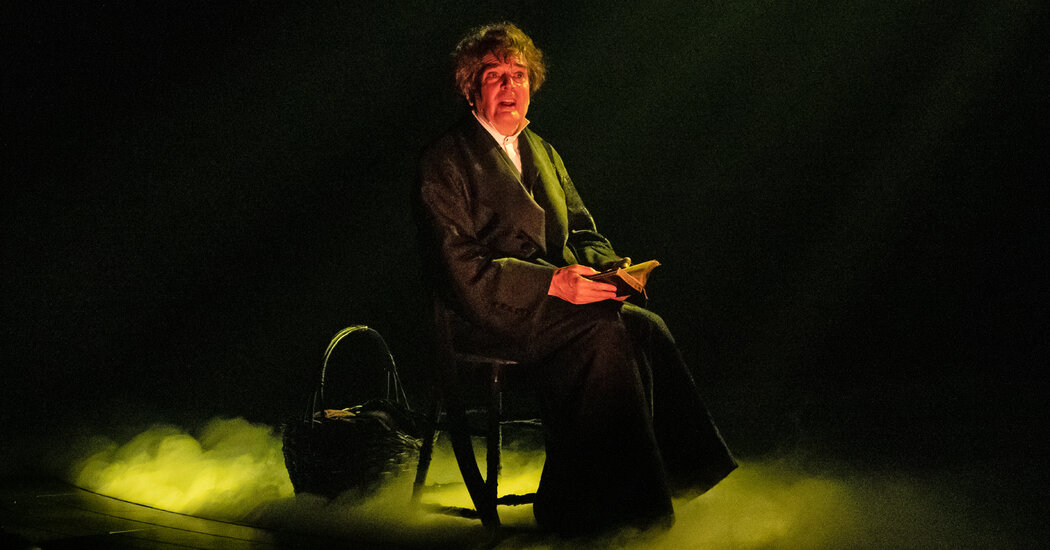
Has Jefferson Mays ever met a role — or a root vegetable — that he hesitated to take on? In the noisy, excitable one-man version of “A Christmas Carol” on Broadway, in a production that opened Monday at the Nederlander Theater, Mays stars as Ebenezer Scrooge, spirits of Christmas, assorted Cratchits, street folk, partygoers. He even plays a boiling potato, straining against a pot lid. At the festive board, Mays is side dish, main course, everything.
Creepy and antic, gloomy and giddy, Michael Arden’s production capitalizes on every trick in Dickens’s story and then pulls a few new ones out of Scrooge’s top hat. Peace on earth? Mercy mild? Please. There are moments when you would swear that Mays couldn’t possibly be unaccompanied, so raucous is this “Carol.” But he is, more or less. (Danny Gardner briefly joins as a wordless specter.) Happily, Mays — who has also triumphed in multiple roles in “I Am My Own Wife,” for which he won a Tony Award, and “A Gentleman’s Guide to Love and Murder” — is a master of manifold parts. If he were left alone, without lights, sound, projections or Dane Laffrey’s curving, swerving set, he might put across this fable even more convincingly.
Dickens’s story was last seen on Broadway in 2019, in a production that had originated in London at the Old Vic. That version wasn’t perfect. (Jack Thorne wrote a script freighted with his usual psychologizing.) But under Matthew Warchus’s direction, that version emphasized community, how we might all join together — actors, audience members, even the people in the cheap seats — to furnish the holiday table. The show emphasized giving and receiving, literalizing the story’s message of generosity and care.
This “Carol,” adapted by Mays, Arden and Mays’s wife, the actress Susan Lyons, and live-captured for streaming two years ago, is a lonelier affair. The script hews closely to the version that Dickens himself toured, with passages of prose narration that cut the goose-fat sentimentality with keen wit and gimlet detail. The broad outlines remain familiar: On Christmas Eve, Scrooge, an ungenerous money lender, is visited by several spirits who help him to understand the boy he was, the man he became and the ways in which his miserliness may reverberate into the future. It’s a kind of spectral exposure therapy. And fast-acting, too. A lone night cures him. In place of a communal gathering, we have one man’s journey toward self-actualization. Scrooge, at last, becomes an integrated person.
Can we say the same of Mays, a man who makes multiple personalities seem like a boon rather than a disorder? He has always been a performer of incandescence and originality. His red-cheeked flame typically burns too bright for realism, though he does sometimes adapt to a slightly lower voltage, as in the fact-based political drama “Oslo.” With his wide forehead and a broad, elastic face, he is an actor of unusual precision, but there’s a vein of waywardness to him, too, a wildness only barely contained. He can sketch a character lightly, with only a half turn and a flutter of his lashes, or debauch himself in orgies of gesture and expression. Rarely can he leave the set or props alone. Cutlery, curtains, the belt of his dressing gown: He makes exuberant use of them all.
The production, conceived by Arden and Laffrey, magnifies that exuberance. Reviewing the 2020 streaming version, Jesse Green described it as “vastly effective as spooky entertainment.” And it is. But in person rather than onscreen, the eerie production elements often overwhelm. It begins with a fog-shrouded coffin and then a thunderclap — an abrupt sound effect that set many in the audience laughing. It also frightened a baby that some parent had unwisely brought. (This is not that kind of “A Christmas Carol.” Leave the babies and the under-12s at home.) The baby screamed so lustily that I missed a lot of the first scene and then had to race to catch up, so swiftly did Mays move through the text, sometimes narrating, sometimes embodying.
And yet the design outpaces him. Ben Stanton’s lighting, flashy and subdued, bathes the stage in crepuscular tones. Joshua D. Reid’s sound design, some of it effective, much of it redundant, rarely ceases. Lucy Mackinnon supplies both highly original production design, like a flash of a ghostly horse, and superfluous embellishments, like a video of party guests glimpsed through a window. (The hair, wig and makeup design are by Cookie Jordan, but as with Laffrey’s costumes, they are barely visible in the murk.) Laffrey’s set is a whirling turntable. Several turntables? Beds, banquets, staircases and cemeteries swing in and out of view — Victoriana at a gallop and a risk for anyone inclined toward motion sickness.
This “Carol” is a breathless entertainment. Is breathing such a bad thing? It might have been nice to have had more respite to appreciate Mays’s closefisted Scrooge, his liberal Cratchit and sweet Fan. But even at this velocity — Mays must run miles each show — he manages to particularize each of the Cratchit children and most of the guests at the Christmas party of Fred, Scrooge’s nephew. At the curtain call, Mays appears spent, but also deeply contented. Like Scrooge, he has had his catharsis and a workout besides. He can rest merry. The rest of us can escape to the relative quiet of Times Square.
A Christmas Carol
Through Jan. 1 at the Nederlander Theater, Manhattan; achristmascarollive.com. Running time: 1 hour 35 minutes.